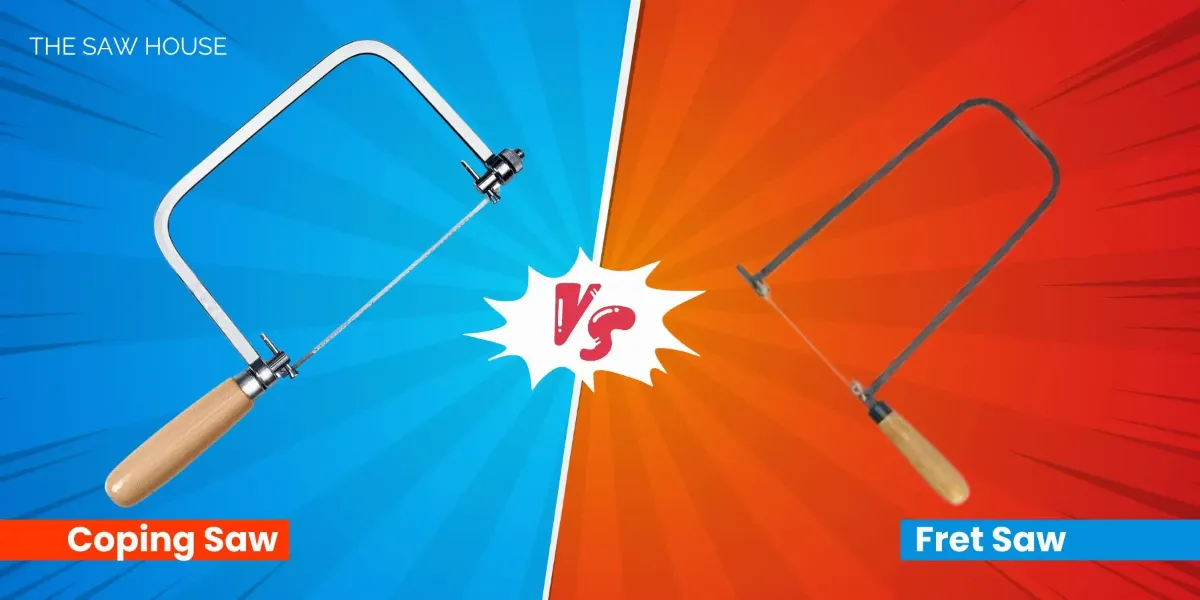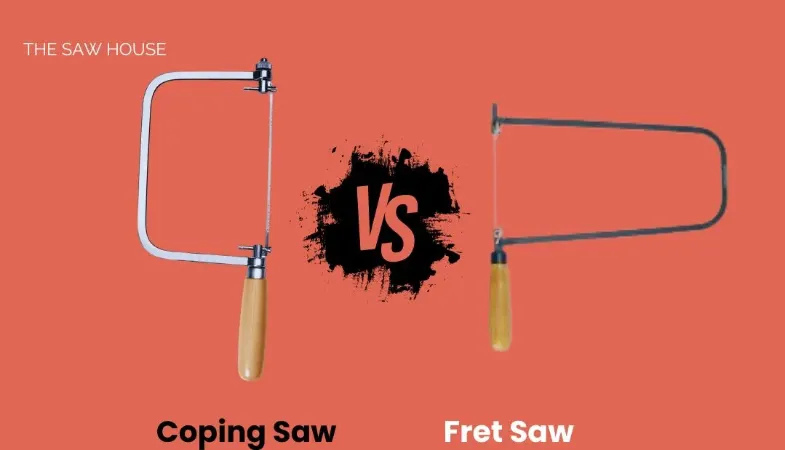Coping saws and fret saws might look similar, but they are designed for different tasks. A coping saw has a narrow blade that is tensioned in a U-shaped frame.
The blade is held in place by pins at the top and bottom of the frame, and it can be removed and replaced as needed. A fret saw also has a U-shaped structure.
But it uses a much thinner blade held in place by a pin at the top of the frame. The blade of a fret saw is also not removable.

Difference Between Coping Saw vs Fret Saw
Coping Saw
A coping saw is a hand-operated tool used mainly by woodworkers to cut detailed curved patterns.
It has a flexible, thin blade that allows you to keep cutting as you push the saw into the material being cut.
The coping saw’s frame is square, and it has an adjustable part at one end so it can stay in place on top of the workpiece while allowing only the blade to move up or down.
Besides wood, a coping saw can also be used on other materials like plexiglass, thin metal pipes, and plastic.
Fret Saw
The fret saw is another hand-operated tool, but it’s used mainly by jewelers and model-makers.
It has an extremely thin, sharp blade that can make exact cuts in various materials like wood, plastic, and fiberglass.
A fret saw’s frame is U-shaped, allowing the blade to move freely up and down. And because the blade is so thin. It can make very tight turns without breaking.
Moreover, the fret saw can also be used to create small, detailed cuts in metal.
Think about the material you’ll be cutting and the types of cuts you’ll need to make.
A coping saw is a good choice if you are working with wood and need to make both straight and curved cuts.
But a fret saw is a better option if you are working with metal and only need to make straight cuts.
When To Use A Fret Saw Vs. Coping Saw?
Now that you know the difference between a coping and a fret saw, you might wonder when to use each one. Here’s a quick guide to help you choose the right tool for the job:
The names fret saw and coping saw may be new to you if a novice woodworker.
Both saws have specific applications, some of which might make them preferable or inferior to a particular task.
When you want to make precise, curved cuts in wood, a fret saw is a tool. The blade on a fret saw is very thin, allowing it to follow the curves of the wood grain.
If you need to cut through more challenging materials, like metal or tile, you’ll want to use a coping saw instead.
Coping saws feature short and stout blades that can handle more strenuous cutting.
Moreover, the blade is the main difference between a coping saw and a fret saw. Coping saws have thicker blades that can be removed and replaced as needed.
Fret saws have thinner blades that are not removable. Choose the right tool for the job by considering the material you’ll be cutting and the types of cuts you need to make.
Pros and Cons of Coping Saws vs Fret Saws
There are several pros and cons to using either a coping or a fret saw. Consider the following before deciding which type of saw is right for the project:

Coping Saw
Pros:
- The blade is easy to remove and replace.
- You can use different types of blades for other materials.
- The frame is adjustable, allowing for precise cuts.
Cons:
- The blade is not as thin as a fret saw blade, making it difficult to make tight turns.
- The blade is not as sharp as a fret saw blade, making it more challenging to make precise cuts.
Fret Saw
Pros:
- The fret saw blade is very thin, allowing for precise cuts.
- It is very sharp, making cutting through more rigid materials easy.
- The frame is not adjustable, making it easier to use.
Cons:
- The blade is not as easy to remove and replace as a coping saw blade.
- You can only use one type of blade with a fret saw.
- The frame is not as adjustable as a coping saw, making it more challenging to make precise cuts.
So, which saw is right for you? It depends on the project you are working on and your personal preferences.
A fret saw is the better option if you need to make precise, curved cuts. But a coping saw is the way to go if you’re looking for an all-purpose saw that can handle different materials and types of cuts.
Safety Precautions of Coping Saws vs Fret Saws
Always take the necessary safety measures when handling any saw to prevent accidental injuries.
Be sure to read the step-by-step guide provided by the manufacturer before using either a fret saw or a coping saw.
So, before using either a coping or a fret saw, it’s essential to take some safety precautions. Here are a few things to keep in mind:
- Always wear safety goggles when using a saw.
- Be careful not to put fingers in the blade’s path.
- Use a clamp or vise to hold the workpiece in place.
- Don’t force the blade through the material.
- Keep the saw blade clean and sharp for the best results.
By following these safety tips, you can avoid accidents and injuries while using either type of saw. As a result, you’ll be able to complete a project safely and successfully.
FAQs
Which Saw Is Best For Beginners?
If you are a beginner, we recommend starting with a coping saw.
Coping saws are less likely to cause accidents since they have thicker blades.
Which Saw Is Easier To Use?
Both coping and fret saws can be easy to use if you take the necessary safety precautions.
Can Either Saw Be Used For Curved Cuts?
No, a coping saw is not meant for curved cuts. The blade is too thick and not sharp enough.
Final Thoughts
After reading this article, you should now have a better understanding of coping saws and fret saws. You should also know the pros and cons of each type of saw.
Consider the material you’ll be cutting and the variety of cuts you need to make before deciding which type of saw is suitable for the project.
Resources:
https://www.fs.usda.gov/about-agency/regulations-policies/saw-policy
